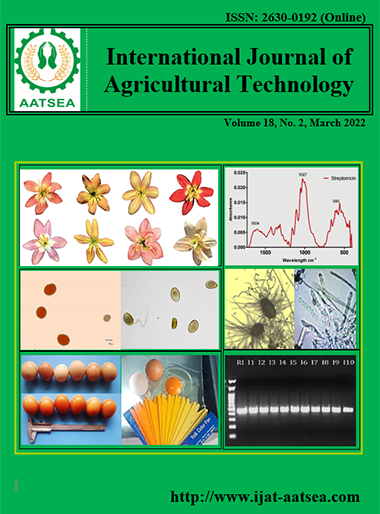Ribeye areas and sizes of fattening culled dairy carcasses determination using plastic grid and geometric methods
Main Article Content
Abstract
The ribeye areas (REA) of fattening culled dairy carcasses which measured using geometric method (GM) were significantly higher than those using plastic grid (PG) method with the averages of 84.12 and 81.42 sq.cm., respectively (p<0.01). The factor of ribeye sizes had highly significantly influenced on REA. The averages of REA for small, medium, and large sizes were 61.94, 80.85, and 105.51 sq.cm., respectively (p<0.01). In addition, the interaction between the fators of method and size affected on the REA. The averages REA of large size measured by GM method was 108.77 sq.cm higher than that measured by PG method 102.26 sq.cm. (p<0.05), whereas there was not significant difference for the small and medium sizes measured by both methods
Article Details

This work is licensed under a Creative Commons Attribution-NonCommercial-NoDerivatives 4.0 International License.
References
ACFS (2004). Thai Agricultural Community and Food Standard TACFS 6001-2547. Ministry of Agriculture and Cooperative. Bangkok. 22 pp.
AHDB (2021). Using the EUROP grid in beef carcase classification. Retrieved from https://ahdb.org.uk/knowledge-library/using-the-europ-grid-in-beef-carcase-classification
AWA (2021). American Wagyu Association. Japan. Retrieved from https://wagyu.org/japan
CBGA (2020). The Canadian Beef Grading Agency: Beef grading. Retrieved from https://beefgradingagency.ca/livestock-grading-in-canada/beef-grading/
Chongcharoen, M. (2003). Carcass quality, cost and return of high quality meat production from crossbred Charolais. (Master Thesis). King Mong’s Institute of Technology Chaokhun Taharn Ladkrabang, Thailand.
Ferreira, O. G. L, Rossi, F. D., Coelho, R. A. T., Fucilini, V. F. and Benedetti, M. (2012). Measurement of rib-eye area by the method of digital images. Brazilian Journal of Animal Science, 41:811-814. https://doi.org/10.1590/S1516-35982012000300047
IBM Corp Released (2011). IBM SPSS Statistics for Windows, Version 20.0. Armonk, NY: IBM Corp.
JMGA (2000). Japan Meat Grading Association: Beef Carcass Grading Standard. Retrieved from https://wagyu.org/uploads/page/JMGA% 20Meat%20Grading%20Brochure_english.pdf
Junkuszew, A. and Ringdorfer, F. (2005). Computer tomography and ultrasound measurement at methods for the body composition of lambs. Small Ruminant Research, 56:121-125.
Karnjanasirm, K., Boonsaen, P., Khongpradit, A., Hattakum, C. and Sawanon, S. (2019). Carcass characteristics, meat quality and consumer satisfaction of feedlot dairy and Kamphaeng Saen steers. King Mongkut's Agricultural Journal, 37:313-323.
Kunya, T. and Nattakan, F. (2017). Association of Dik2670 Microsatellite Marker with Carcass Traits in Crossbred Beef Cattle. International Journal of Agricultural Technology, 13:1077-1086.
Lemaster, J. W. (1999). Ultrasound Evaluation to Improve Carcass Merit. University of Florida, Gainesville, Department of Animal Science. Retrieved from https://animal.ifas.ufl.edu/beef_extension/bcsc/1999/pdf/lemaster.pdf
Luz e Silva, S., Leme, P. R., Pereira, A. S. C. and Putrino, S. M. (2003). Correlations among carcass characteristics taken by ultrasound and after slaughter in Nellore steers fed high concentrate diets. Revista Brasileira de Zootecnia, 32:1236-1242. https://doi.org/10.1590/S1516-35982003000500026
McKinnon, B. R. (2000). Beef Quality Corner - The Need for More Muscle. Extension Animal Scientist, Marketing, Virginia Tech, Livestock Update, November 2000, http://www.ext.vt.edu/news/
MLA. (2018). Australian Beef Carcase Evaluation: Beef and Veal Chiller Assessment Language. Retrieved from https://www.ausmeat.com.au/ WebDocuments/Chiller_ Assessment_Language.pdf
Nunes, J. L., Piquerez, M., Pujadas, L., Armstrong, E., Fernández, A. and Lecumberry, F. (2015). Beef quality parameters estimation using ultrasound and color images. BMC Bioinformatics, 16:S6. doi: 10.1186/1471-2105-16-S4-S6.
Prom-In, V. (2006). Carcass and meat quality of beef steers under production system of Kamphaengsaen Beef Cooperative. (Master Thesis). King Mong’s Institute of Technology Chaokhun Taharn Ladkrabang, Thailand.
Sawanon, S. (2012). Male dairy cattle: Possibility for bringing to produce quality beef. Kasetsart Livestock Magazine, 39:32-40.
Sukjai, W., Opatpatanakit, Y. and Supphakitchanon, T. (2012). Carcass and meat quality of culled dairy cows with different slaughter weight and age. Khon Kaen Agriculture Journal, 40:18-24 (in Thai).
Supphakitchanon, T. (2004). Carcass quality, cost and return of high quality meat production from Brahman beef cattle. (Master Thesis). King Mong’s Institute of Technology Chaokhun Taharn Ladkrabang, Thailand.
Tatum, D. (2020). Beef Grading Department of Animal Science, Colorado State University Ft. Collins, CO. Retrieved from https://fyi.extension.wisc.edu/wbic/files/2011/04/Beef-Grading.pdf
Tuntivisoottikul, K. and Worawong, K. (2017). Cattle groups and pairs of permanent incisor teeth influenced carcass traits. Agricultural Science Journal, 48:859-867, (in Thai).
Waylan, A. T., Campbell, R. E. and Unruh, J.A. (1997). Use of video image analysis, ribeye grids, and linear ribeye measurements to predict and compare ribeye areas from carcass left and right sides. Kansas Agricultural Experiment Station Research Reports, 0(1). https://doi.org/10.4148/2378-5977.1911
Y´añez, E. A., Ferreira, A. C. D., Medeiros, A. N., Pereira Filho, J. M., Teixeira, I. A. M. A. and Resende, K. T. (2006). Methodologies for ribeye area determination in goats. Small Ruminant Research, 66:197-200.


